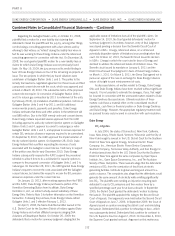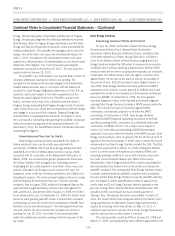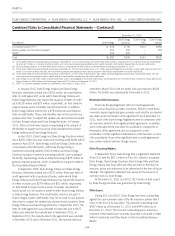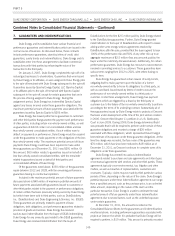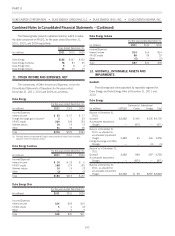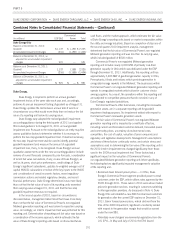Duke Energy 2011 Annual Report Download - page 161
Download and view the complete annual report
Please find page 161 of the 2011 Duke Energy annual report below. You can navigate through the pages in the report by either clicking on the pages listed below, or by using the keyword search tool below to find specific information within the annual report.
PART II
DUKE ENERGY CORPORATION •DUKE ENERGY CAROLINAS, LLC •DUKE ENERGY OHIO, INC. •DUKE ENERGY INDIANA, INC.
Combined Notes to Consolidated Financial Statements – (Continued)
In September 2010, Duke Energy Carolinas converted $100
million of tax-exempt variable-rate demand bonds, to tax-exempt term
bonds, which carry a fixed interest rate of 4.625% and mature
November 1, 2040. In connection with the conversion, the
tax-exempt bonds were secured by a series of Duke Energy Carolinas’
first mortgage bonds.
In September 2010, Duke Energy Indiana refunded $70 million
of tax-exempt auction rate bonds through the issuance of $70 million
principal amount of tax-exempt term bonds, of which $60 million
carry a fixed interest rate of 3.375% and mature March 1, 2019 and
$10 million carry a fixed interest rate of 3.75% and mature April 1,
2022. In connection with the conversion, the tax-exempt bonds were
secured by a series of Duke Energy Indiana’s first mortgage bonds.
Non-Recourse Notes Payable of VIEs.
To fund the purchase of receivables, CRC borrows from third
parties and such borrowings fluctuate based on the amount of
receivables sold to CRC. The borrowings are secured by the assets of
CRCandarenon-recoursetoDukeEnergy.Thedebtisrecordedas
short term as the facility has an expiration date of October 2012. At
December 31, 2011 and 2010, CRC borrowings were $273 million
and $216 million, respectively, and are reflected as Non-Recourse
Notes Payable of VIEs on Duke Energy’s Consolidated Balance
Sheets.
Non-Recourse Long-Term Debt of VIEs.
In December 2010, Top of the World Wind Energy LLC, a
subsidiary of DEGS, an indirect wholly-owned subsidiary of Duke
Energy, entered into a long-term loan agreement for $193 million
principal amount maturing in December 2028. The collateral for this
loan is substantially all of the assets of Top of the World Windpower
LLC. The initial interest rate on the notes is the six month adjusted
LIBOR plus an applicable margin. In connection with this debt
issuance, DEGS entered into an interest rate swap to convert the
substantial majority of the loan interest payments from a variable rate
to a fixed rate of 3.465% plus the applicable margin, which was
2.375% as of December 31, 2011. Proceeds from the issuance will
be used to help fund the existing wind portfolio.
In May 2010, Green Frontier Wind Power, LLC, a subsidiary of
DEGS, an indirect wholly-owned subsidiary of Duke Energy, entered
into a long-term loan agreement for $325 million principal amount
maturing in 2025. The collateral for this loan is a group of five wind
farms located in Wyoming, Colorado and Pennsylvania. The initial
interest rate on the notes is the six month adjusted London Interbank
Offered Rate (LIBOR) plus an applicable margin. In connection with
this debt issuance, DEGS entered into an interest rate swap to convert
the substantial majority of the loan interest payments from a variable
rate to a fixed rate of 3.4% plus the applicable margin, which was
2.5% as of December 31, 2011. Proceeds from the issuance will be
used to help fund the existing wind portfolio. As this debt is
non-recourse to Duke Energy, the balance at December 31, 2011
and 2010 is classified within Non-Recourse Long-term Debt of VIEs
in Duke Energy’s Consolidated Balance Sheets.
Money Pool.
The Subsidiary Registrants receive support for their short-term
borrowing needs through participation with Duke Energy and certain
of its subsidiaries in a money pool arrangement. Under this
arrangement, those companies with short-term funds may provide
short-term loans to affiliates participating under this arrangement. The
money pool is structured such that the Subsidiary Registrants
separately manage their cash needs and working capital
requirements. Accordingly, there is no net settlement of receivables
and payables between the money pool participants. Per the terms of
the money pool arrangement, the parent company, Duke Energy,
may loan funds to its participating subsidiaries, but may not borrow
funds through the money pool. Accordingly, as the money pool
activity is between Duke Energy and its wholly-owned subsidiaries,
all money pool balances are eliminated within Duke Energy’s
Consolidated Balance Sheets. The following table shows the
Subsidiary Registrants’ money pool balances and classification within
their respective Consolidated Balance Sheets as of December 31,
2011 and 2010.
December 31, 2011 December 31, 2010
(in millions) Receivables Notes Payable Long-term Debt Receivables Long-term Debt
Duke Energy Carolinas $923 $ — $300 $339 $300
Duke Energy Ohio 311 — — 480 —
Duke Energy Indiana — 300 150 115 150
Increases or decreases in money pool receivables are reflected
within investing activities on the respective Subsidiary Registrants
Consolidated Statements of Cash Flows, while increases or decreases
in money pool borrowings are reflected within financing activities on
the respective Subsidiary Registrants Consolidated Statements of
Cash Flows.
Accounts Receivable Securitization.
Duke Energy Carolinas securitizes certain accounts receivable
through Duke Energy Receivables Finance Company, LLC (DERF), a
bankruptcy remote, special purpose subsidiary. DERF is a wholly-
owned limited liability company with a separate legal existence from
its parent, and its assets are not intended to be generally available to
141



